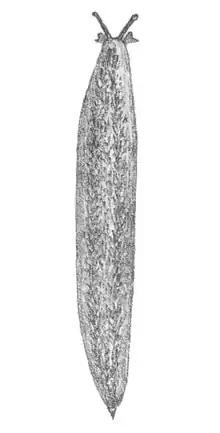| Rathouisia leonina | |
|---|---|
 | |
| Drawing of Rathouisia leonina (dorsal aspect) by Charles Rathouis | |
| Scientific classification | |
| Kingdom: | |
| Phylum: | |
| Class: | |
| (unranked): | |
| Superfamily: | |
| Family: | |
| Genus: | |
| Species: | R. leonina |
| Binomial name | |
| Rathouisia leonina | |
| Synonyms[2] | |
|
Vaginulus sinensis Heude, 1882 | |
Rathouisia leonina is a species of carnivorous air-breathing land slug, a terrestrial pulmonate gastropod mollusk in the family Rathouisiidae. This species is endemic to China.
This slug is carnivorous and actively preys on snails. It is usually grayish brown to dark gray in color with scattered black spots on the upper surface of the body. The bottom surface of the foot is a light reddish brown. These slugs inhabit environments with high humidity and shade, such as foothills and city gardens, although they are rarely seen.
Taxonomy
Rathouisia leonina was first described by the French missionary and zoologist Pierre Marie Heude in 1882. It is the type species of the genus Rathouisia, which was named in honor of the Jesuit Père Charles Rathouis who made the original drawings of the specimens for Heude.[1][2]
The specific name leonina is from Latin word "leo", which means lion, referring to the predatory nature of the slug.
Distribution
Rathouisia leonina is endemic to China. It is found in the following areas:[2]
- Eastern China: the foothills of the Purple Mountain, Nanjing in Jiangsu province
- Central China: Yichang in Hubei province
- Southern China: Shaoguan in Guangdong province
- Southwest China: Chengkou County in Sichuan province, along the Yangtze River
Description

Digestive system:
BM - buccal mass
SD - salivary duct
SG - salivary gland
OE - oesophagus
AN - anus
I - intestine
ST - stomach
DG - digestive gland
other organs:
P - position of the pneumostome
H - heart
OT - ovotestis.
Rathouisia leonina has a cylindrical and elongated body, with a resting length of less than 35 mm (1 in). The body color usually ranges from light grayish-brown to dark gray, rarely reddish. The bottom surface (sole) is light reddish brown. The upper surface of the body has scattered black oblong spots. The tentacles are short and black in color.[2]
Rathouisia leonina is larger than its two congeners, Rathouisia pantherina and Rathouisia tigrina. Adults weigh from 0.18 to 1.02 g. Their mucus is very sticky.[2]
Ecology
Habitat
Rathouisia leonina often inhabits areas with high humidity and shade, but can also live in open habitats and in dry environments. These slugs are usually found in limestone hills, foothills, and city gardens, though they are not often seen. They commonly rest under thick litter and rocks during the dry season. They only move on laterite soil (without litter) during the humid season. They are actively crawling at temperatures of 4 to 35.5 °C (39 to 96 °F).[2]
Feeding habits
Rathouisia leonina is a predatory carnivorous slug. It exclusively preys on snails, which it attacks through their aperture. The common natural prey species of Rathouisia leonina include the following:[2]
- Bradybaenidae: Bradybaena similaris, Acusta ravida, Trichobradybaena submissa. It also eats the eggs of the mentioned species of Bradybaenidae.[2]
- Subulinidae: Opeas arctipsirale[2]
- Succineidae[3][4]
In laboratory experiments, this slug also preyed upon Cathaica fasciola (Bradybaenidae), Cornu aspersum (Helicidae), and Achatina fulica (Achatinidae). It does not prey on other slugs.[2]
Life cycle
Rathouisia leonina lays clutches of 10 to 49 eggs. The eggs are spherical or ellipsoidal in shape, with a diameter of 1.88 to 3.09 mm (0.07 to 0.12 in). The eggs are a translucent light smoke-blue or light pink in color.[2] Juveniles hatch from the eggs after 25 to 29 days when kept in temperatures of 17.5 to 23.5 °C (64 to 74 °F).[2]
References
- 1 2 (in French) Heude P. M. (1882–1890). "Notes sur les Mollusques terrestres de la vallée du Fleuve Bleu". Mémoires concernant l'histoire naturelle de l'empire chinois par des pères de la Compagnie de Jésus, Mision Catholique, Chang-Hai. page 10, plate 13, fig. 2, page 100, page 131, plate 32.
- 1 2 3 4 5 6 7 8 9 10 11 12 Wu M., Guo J.-Y., Wan F.-H., Qin Q.-L., Wu Q. & Wiktor A. (2006). "A preliminary study of the predatory terrestrial mollusk Rathouisia leonina". The Veliger 48: 61-74.
- ↑ Rathouis C. (1884). "Quelques remarques sur les moeurs et habitudes du Rathouisia leonina". Mémoires Concernant l'Histoire Naturelle de l'Empire Chinois 1884: 131-132.
- ↑ Barker G. M. (2004). Natural Enemies of Terrestrial Molluscs. CABI Publishing, 644 pp., page 337.
External links
 Media related to Rathouisia leonina at Wikimedia Commons
Media related to Rathouisia leonina at Wikimedia Commons